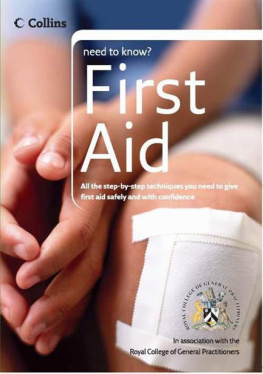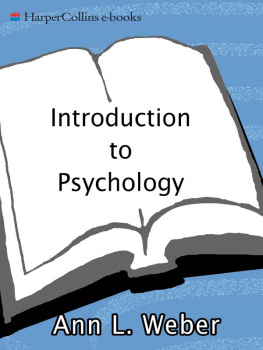Collins Need to Know?
First Aid
In association with the Royal College of General Practitioners
Sheena Meredith MB BS MRCS (Eng) LRCP (Lond)
Consultant: Dr Vincent Forte BA MB BS MRCGP MSc DA

Table of Contents
In my role as Vice-Chairman of the Patient Partnership Group, people often tell me just how important it is for them to have easy-to-understand health information. This is never more true than when it comes to dealing with accidents and emergencies. Whether your situation calls for a doctors attention, or you need an ambulance urgently, there are often many things that you can do to at the scene of the accident to improve the situation.
Written by a family doctor, Need to know? First Aid covers all the situations you might encounter and helps you to take effective action. You dont need to be trained in first aid to use this book, although I hope that it might encourage you to find out more, and perhaps take a course.
It has been endorsed by the Royal College of General Practitioners, so the information here combines a common sense approach with a large number of practical techniques. Most accidents happen in or around the home. Did you know, for example, that using the stairs is, minute for minute, one of the most dangerous things we do every day? You will find information on how to prevent accidents occurring, as well as being prepared for them by knowing what to keep in your first aid kit, for example.
There is a crucial section on life saving, which explains resuscitation techniques in children and adults. I would recommend that you give this a quick read-through before you put the book somewhere close at hand. This will ensure that you know whats covered and how to find the relevant information quickly should an emergency arise. You will see that there is a clear and logical A-Z listing of specific situations from fainting and fever to splinters and sunburn. This will help you to deal with problems and emergencies without panicking, even if you have no first aid training.
On a practical note, keep your book in an easy-to-find place and make sure everyone in the household knows where its kept. Should you find yourself in an emergency, remember that you can quickly pull out the essential life-saving techniques information from inside the front cover.
Dr Catti Moss MA FRCGP
Medical Vice-Chairman, Patient Partnership Group
Royal College of General Practitioners
Having the essential items to hand can make all the difference when it comes to performing first aid. This section looks at common accident situations and also details the items you should keep to hand both at home and while out and about. The most important of these is a properly stocked first aid kit, which, alongside your own ability to keep calm and assess the situation at hand, will stand you in good stead for any incident that may arise.
Emergency priorities
Accidents and medical emergencies happen every day, any time, anywhere. Even if you have no first aid training, your intervention could help to limit the damage and maybe even save a life.
Priorities in an emergency
Anyone could come across the scene of an accident, or suddenly be faced with an emergency at home. The key is to call for help, keep calm, assess the situation and know what to do in those vital minutes while awaiting help.
1 Stop to assess the situation watch out for danger.
Your first aim is to avoid anyone else being put at risk for example, from oncoming traffic in a road accident.
2 Make sure it is safe to approach the scene
Never put yourself at risk it is no help if you become a second casualty. If you cannot help without endangering yourself or others, call or send for help and keep others away.
3 Make the area safe
Do what you can to protect bystanders and others from danger and protect the casualty from further danger.
4 Assess the victim
Check the casualtys response and condition (see pages 32-33).
5 Call for help
6 Resuscitate and treat injuries as necessary
Vital contact numbers
In an emergency there are several ways to summon help and assistance. In the majority of cases this will be by dialling 999 from any phone.
Emergency contact numbers:
| Police, fire and ambulance services | |
| European Union Emergency number | |
| HMS Coastguard | |
| Mine, mountain and cave rescue | |
Medical advice:
| NHS Direct | 0845 46 47 |
| NHS24 (Scotland) | 08454 24 24 24 |
| Doctor |
| Local hospital |
| Dentist |
Local utilities:
| Gas supplier |
| Electricity supplier |
| Water supplier |
| Local council |
First aid kits
must know
Keep your first aid kit well stocked at all times as you never know when it might be useful.
Make sure everyone in the household or workplace knows where the first aid kit is kept.
A well-stocked first aid kit can make dealing with minor accidents and injuries much easier.
Home first aid kit
As well as the full range of items that you will wish to keep in the house, its a good idea to keep a first aid kit and other useful items in the car, in case you encounter an emergency situation while out and about. You can buy ready-made kits from most pharmacies, or you can put together your own. Store items in a clean, waterproof container with a well-fitting lid, and clearly mark it first aid.
Car first aid kit
As well as the essential items for a standard first aid kit, you may also wish to carry:
face shield or mask to protect you when performing resuscitation
cardboard tie-on labels to identify casualties in major incidents
notebook and pen for recording observations
blanket
cushions
strong torch
whistle
survival bags or rolls of kitchen foil for keeping casualties warm and dry
Maintaining a first aid kit
other items to include
bandage clips or safety pins
disposable gloves
tubular bandages for finger injuries
large cotton-wool strips for padding
eye pad
thermometer
wound-closure strips (steri-strips)
If you use an item, be sure to replace it as soon as possible.
Check the contents regularly at least once a year and replace any out-of-date items.
Store in a high cupboard out of reach of small children.
Make sure the kit remains clean and dry: dont store it anywhere that could get damp, such as in a cupboard above the kettle or next to a window thats prone to condensation, or too hot, such as in a cupboard over the oven.
Make sure the kit is clearly labelled so anyone can locate it in an emergency.
Holiday first aid kit
must know
In addition to your travel first aid kit make sure that you have the correct immunisations for your destination(s). Check with your doctor about what you might need and leave plenty of time as immunisations must be administered over several weeks.
It is well worth taking a comprehensive first aid kit with you when travelling, especially if you are going to remote areas, taking small children along or planning to engage in outdoor or sporting activities.













